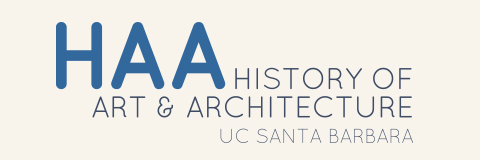Welcome to the Department of History of Art & Architecture at
University of California, Santa Barbara
Our teaching faculty is comprised of archeologists, curators, cultural geographers, art historians, and architectural historians. We are proud to offer a full range of course offerings spanning from the ancient world all the way through to our present moment, with an emphasis on global perspectives and intercultural exchanges. The teaching and research interests of our faculty represent the following broad areas of expertise:
- Art, Architecture, and Material Cultures of the Pre-Modern World
- Art, Architecture, and Material Culture of the Americas
- Art and Material Culture of the Early Modern World
- Architecture, Urbanism, Environmentalism
- Studies in Modernism and Cultural History
- Contemporary Art, Architecture, and Material Culture
- Museum and Curatorial Studies
Across these diverse areas, our department is uniquely non-canonical: championing overlooked and forgotten histories across many modalities: architectural renderings, the built environment, cities, ceramics, gaming, digital media, installation, painting, photography, print, sculpture, and textiles. We are committed to fostering global and interdisciplinary scholarship with particular strengths in the Americas, Asia, Africa, and Europe. Collectively, our faculty are prize-winning authors and have been awarded prestigious fellowships from the American Academy, Berlin; the American Academy, Rome; the American Council of Learned Societies; Dumbarton Oaks; the Fulbright-Hays Fellowship; the Getty Research Institute; the Guggenheim Foundation; the Huntington Foundation; the National Endowment for the Humanities; and the Smithsonian American Art Museum.
In the undergraduate curriculum, the department also offers two interdisciplinary undergraduate specializations, known as an Emphasis. These are: Architecture & Environment, a program that situates the study of architecture within a complex web of social and geo-political histories and Museum Studies, a program designed to integrate historical and theoretical questions into a framework of professional practice, while encourage hands-on experiences through the internship practicum.
There is also a new interdisciplinary Minor in Game Studies, which is designed for students who are interested in game studies (of all types) who wish to acquire focused training in the visual and material culture, history, theory, development, programming, narrative, and production of games. Involving scholars from History of Art & Architecture, Film and Media Studies, English and Writing, Computer Science, Communication, Psychology, Sociology, and Education, it encompasses the aesthetics, cultural and historical contexts, sociopolitical implications, and the design (visual and narrative) of games.
The department’s Ph.D. graduate program balances rigorous methodological analysis with pedagogical training necessary to cultivate the original thinking that is essential to a doctoral student’s future career path. Many of our doctoral alumni go on to illustrious museum careers. Students are encouraged to utilize individual and collective faculty expertise to create specific fields of historical inquiry, working toward the development of a dissertation project. We are especially proud that our students learn to teach as generalists: trained in disseminating knowledge far beyond their own areas of specialization. We are committed to cultivating flexibility and open pathways for the next generation of scholars, professors, and curators pursuing humanistic inquiry.
Please note, we do not have a stand-alone M.A. program.
Statement on Student Diversity
Through the study of art and architecture, the Department of History of Art & Architecture affirms the richness and diversity of our constructed visual and material worlds. Its remarkable range and depth is a proud reflection of the variety and difference that marks us as humans. As a department, we are committed to understanding and and offering the historical tools and training that celebrate and bolster diversity. It is our mission to be inclusive. We welcome students from diverse ethnic and socio-economic backgrounds, including minority-identified, queer and non-binary, and first-generation college students. We are committed to a fully inclusive history of art and architecture that explores ethnic, racial, economic, sexual, and religious differences. We are strongly dedicated to encouraging and supporting future art and architectural historians and professionals from underrepresented backgrounds pursuing underrepresented histories.
Affiliated Departments and Programs

